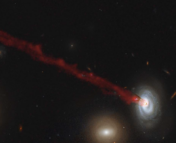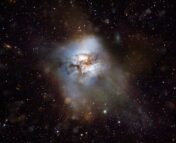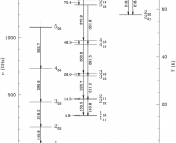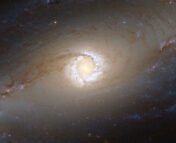Title: LoTSS jellyfish galaxies III. The first identification of jellyfish galaxies in the Perseus cluster
Authors: I.D. Roberts, R. J. van Weeren, R. Timmerman, A. Botteon, M. Gendron-Marsolais, A. Ignesti, and H. J. A. Rottgering
First Author’s Institution: Leiden Observatory, Leiden University
Status: Published in Astronomy & Astrophysics, available here and on the arXiv
Our Universe is an ocean full of objects on various size scales. The largest objects held together by gravity are galaxy clusters. The extreme environment of clusters can dramatically influence the galaxies within. Two main types of such environmental quenching include gravitational interactions and hydrodynamical interactions, which is where ram-pressure stripping (RPS) makes a chaotic splash in today’s reading. When a galaxy is swimming through the intracluster medium (ICM), it experiences ram pressure, the effective pressure exerted on an object as it moves through a fluid medium (i.e. the ICM). If strong enough to overcome the force of gravity keeping the galaxy together, it can strip the galaxy of its gas, influencing star formation (SF) in the galaxy both by removing cold gas (leading to rapid quenching) and by driving increased densities in the interstellar medium (ISM) that can lead to bursts of SF. Today’s authors present the first systematic search for galaxies undergoing RPS in the Perseus Cluster. Such galaxies are often referred to as ‘jellyfish’ galaxies due to their one-sided radio tails extending asymmetrically about the optical center of the galaxy (Fig. 1). Let’s dive into more details!

How to Catch Jellyfish
Roberts et al. used multiwavelength observations to fish for jellyfish galaxies in Perseus. Low-frequency 144 MHz radio imaging of the cluster was used from the LOFAR Two-metre Sky Survey, which resulted in a high quality image covering the central 2 square degrees of the cluster. To constrain spectral properties of the galaxies identified, the authors also used Karl G. Jansky Very Large Array (VLA) 344 MHz imaging observations. The authors obtained spectroscopic redshifts of galaxies within the LOFAR field from the NASA IPAC Extragalactic Database and optical magnitudes from the Sloan Digital Sky Survey DR16. After constraints, the final sample totaled 166 member galaxies within 1 degree of the Perseus Cluster center. The authors separated these galaxies into quiescent (150) and star forming (16) based on color (Fig. 2).
Following selection criteria from their previous studies, they visually inspected optical Subaru Hyper Suprime-Cam Legacy Archive and LOFAR images for all SF galaxies. Jellyfish galaxies were identified as those with 144 MHz emission that had an extended, one-sided asymmetry with respect to the galaxy’s stellar distribution (as traced by the optical image). Four jellyfish galaxies were identified: LEDA 2191078, MCG +07-07-070, UGC 2654, and UGC 2665. H-alpha + [N II] imaging from the Isaac Newton Telescope probed sub-kiloparsec scales and showed that H-alpha + [N II] and therefore SF, is enhanced along the leading side of the jellyfish galaxies, as expected when gas is compressed due to ram pressure.

Reeling them In
Now that the authors have caught some jellyfish galaxies, they used LOFAR and VLA imaging to analyze the spectral indices (basically how the intensity of the radio continuum emission varies with frequency) of three of them over the disk and tail (Fig 3). This is a unique result of the study, since there are few spectral index measurements for RPS tails in jellyfish galaxies. They tried to constrain indices in order to better understand the origins of synchrotron emission in the tails. The authors find that the tail spectral indices are steeper than those of the disk, ranging between -0.4 and -0.2. This is consistent with flattening due to ionization losses in a high density ISM, as expected at the low frequencies being probed and the fact that ram pressure is compressing the jellyfish galaxies and enhancing their ISM densities. The stripped tail indices are not well constrained for various reasons and within their uncertainties are consistent with both the expected injection spectral index from active SF and moderate steepening due to synchrotron aging (radiation losses).
The authors also explored the radio luminosity versus number of stars forming per year (SFR) to discover if the Perseus jellyfish exhibit large 144 MHz luminosities similar to the LOFAR jellyfish galaxies analyzed in Roberts+ 2021a. To do this they used infrared WISE images and followed WISE4-only photometric data reduction methods of Leroy+2019 to determine SFRs via the relationship . Figure 3 (right) shows this relationship, where we see the jellyfish (large blue symbols) display excess 144 MHz emission relative to normal SF galaxies. The authors discuss this offset from the standard relation, but the physical origin of enhanced radio emission is still an open question and extra data to probe the various mechanisms will be needed to further dive into this question.

The Bottom Line
The takeaway from this jellyfishing endeavor is that the authors make the first identification of galaxies undergoing ram-pressure stripping in the Perseus Cluster. Jellyfish galaxies are most easily identified by their one-sided tails seen at radio wavelengths, but observations at optical bands showed morphological consistency with ongoing RPS.
- All four galaxies show evidence for enhanced star formation on the leading side of the galaxy.
- Within 144-344 MHz, the Perseus galaxies have flatter spectral indices over the disk region than the tail, which may be due to ionization losses. The tail indices are consistent with what is expected from star formation as well as synchrotron aging, so they are unable to fully constrain what processes are going on.
- Overall, Perseus jellyfish galaxies have higher 144 MHz luminosities relative to the standard relationship, which has been reported for other jellyfish. The physical mechanism(s) of this is an ongoing question, which more data will help answer in future studies.
Astrobite written by Stephanie Podjed. Featured image credit: Stephanie Podjed
Astrobite edited by Yoni Brande




